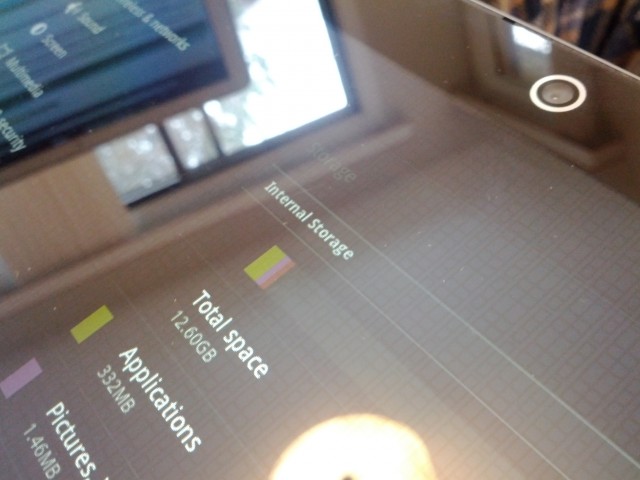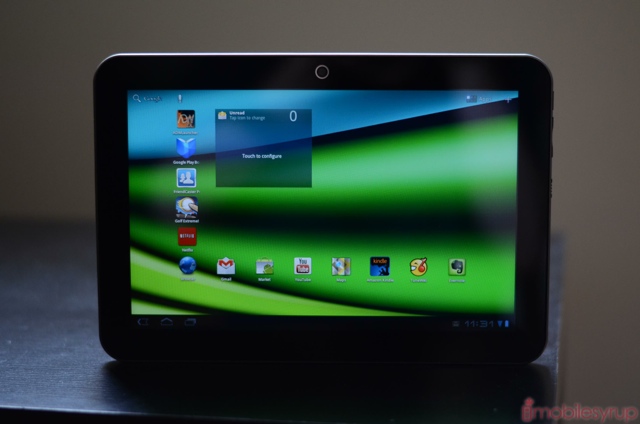
The Toshiba Excite 10 LE is the company’s follow-up to the intriguing, and yet ultimately disappointing, Thrive tablet from last year. In exchange for full-sized ports and a removable battery, Toshiba has slimmed down the Excite to a lithe 7.7mm, updated its industrial design and raised the price. Is the tradeoff worth the extra bucks? And how does it match up to the rest of the Android tablet market? Read on to find out.
Specs:
– Android 3.2.1 Honeycomb
– 10.1-inch 1280×800 IPS display w/ Gorilla Glass
– 1.2Ghz TI OMAP 4430 dual-core processor
– 1GB RAM, 16GB/32GB internal storage
– 5MP back camera with flash, 2MP front camera
– WiFi (b/g/n), Gyroscope, Accelerometer, GPS, eCompass
– microUSB, microSD slot, miniHDMI port
– Stereo speakers with SRS Digital sound codec
– 25Whr battery with 8hrs battery life
– 10.1″ (W) x 6.9″ (D) x 0.3″ (H) (25.6cm x 17.5cm x 7.7mm)
– 535g
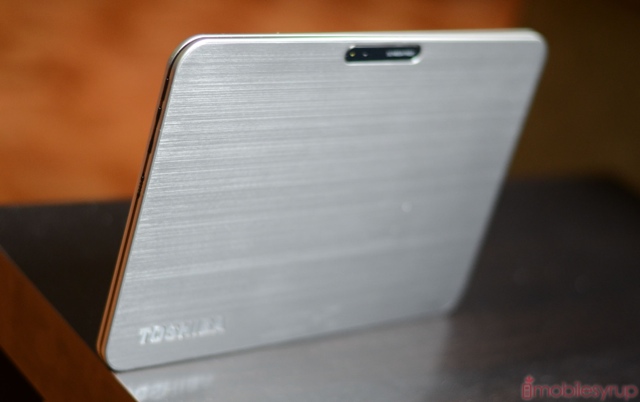
Design:
At 7.7mm, it is one of the thinnest tablets we’ve used, and the metallic-looking body practically screams ‘premium’ upon first viewing. And while a world of improvement over the Excite’s predecessor, the build quality leaves a lot to be desired. Toshiba tries very hard to convince us into thinking the Excite is made of metal, but the magnesium alloy used for the backing feels all too much like plastic. The rear of the device looks to have been glued on, as certain areas show seams while others are tightly fastened. Besides exposing the Excite to dust, dirt and other unpleasantries, there is a sense of haphazardness here that, for the price, shouldn’t be.
The screen bezel is blissfully thin, and the perimeter of the tablet is circumnavigated by a strip of colour-matching plastic with a stripe of black in the middle. The right side holds the various buttons — power, volume and an orientation lock switch — which blend so exquisitely into the framework as to be almost unnoticeable. It reminds me of those wall panel fridge units that you don’t notice until your host opens it to reveal a perfectly stacked shelf of beers.
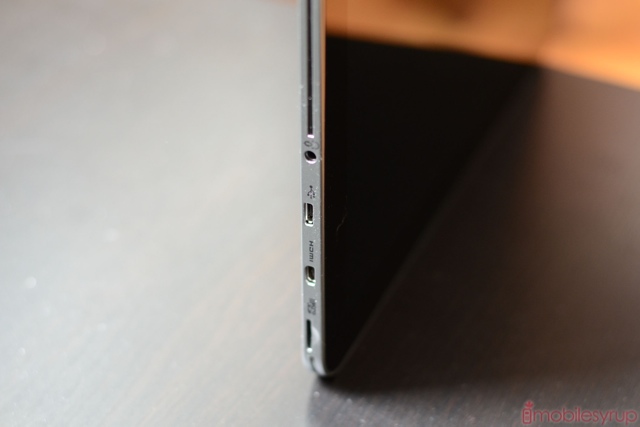
On the left we have our array of ports: a headphone jack, microUSB input, mini HDMI out and microSD slot. On the bottom is the largest dock connector port I’ve ever seen, some 30% wider than Apple or Samsung’s proprietary port. The only way to charge the device is with the accompanying cable which is thick and unruly, and just another cable to carry with you on the plane.
The Excite 10 LE has a camera conundrum. On the back, a small strip of glossy black glass covers the LED flash and 5MP camera sensor. If this was on the front, it would blend right in. But for some reason Toshiba felt it necessary to highlight the front-facing camera with a circular ring of silver, in so distracting a fashion as to be unfathomable. I was constantly distracted by this “eye” staring at me as I worked.
Yes, the Excite 10 LE is thin and light, but it takes liberties in materials where is shouldn’t, and has some inexplicable design choices. At 535g it is lighter still than the Galaxy Tab 10.1, and can thusly be held in one hand without discomfort. Due to the thin bezel, the tablet doesn’t come off as grotesque in portrait mode, despite the same 16:9 aspect ratio of other Android tabs. In terms of design, the Excite does more things right than wrong, but that’s not excusing the things that are done very wrong.
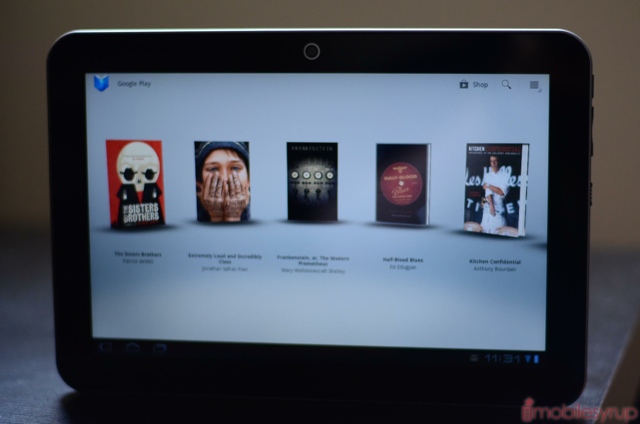
Display:
Though the Excite has an IPS display, I noticed some problems with it right away. First, the good stuff: viewing angles are excellent, as one would expect from IPS, and maximum brightness is sufficient for most outdoor use. Colour is reasonably accurate, with decent saturation levels, and though at low brightness they are more grey than I would like, whites are vibrant and clear at max brightness. At 1280×800, media looks good, and text is readable with no lack of sharpness.
The digitizer supports 10 touch points, which would be fine if it responded adequately to one finger. I found myself having to press down harder than I would have on another tablet to achieve the same results, while the back/home/multitasking buttons on the bottom seemed to spurn even my sternest directions. While brightness is good, I identified a constant flicker in certain areas of the screen, as if suffering from an asynchronous refresh rate (like in the old CRT days). When viewed in the dark the screen had hotspots of backlight bleeding.
Lastly, but certainly not least, the screen is entombed in a repeating square/rectangle pattern that seems be a product of the digitizer. Regardless of its origin, picture quality suffers as a result and it was a constant distraction for me when doing regular activities like surfing the web or watching a movie. While less obvious on a white background, the pattern, combined with the relentless flickering, made the Excite one of the least pleasant viewing experiences I’ve had on a tablet.
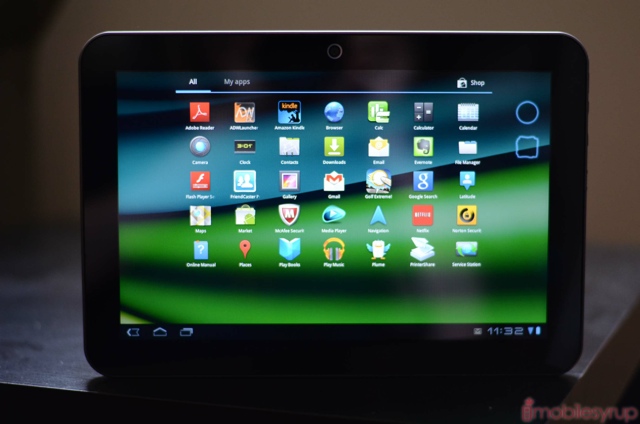
Performance:
The Excite’s lack thereof doesn’t end at its mediocre screen or faux chic design. There is a lot to like above board: at first glance the tablet looks great, and only really breaks down once you get to using it. Internally, however, things are a bit different, and not for the better.
Sporting a 1.2Ghz dual-core TI OMAP 4430 processor and 1GB RAM, the Excite is largely underpowered for a new tablet. This is the same processor that has powered smartphones since early 2011, from the Motorola XT860 to the LG Optimus 3D to the BlackBerry Playbook. Alongside two 45nm Cortex A9-based cores, the chip uses PowerVR’s SGX540 GPU, a part that too is becoming long in the tooth. Compare that with the new iPad’s quad-core PowerVR SGX543MP4+ chip, which has a potential fill rate of over four times the Excite, and you can see where the problems arise. A year ago launching a tablet with this chipset would have been acceptable; now it is unconscionable.
Benchmark results seem to confirm my suspicions: most were akin to last year’s phone scores, and don’t come close to the Tegra 3 or even last-generation Snapdragon S3 scores. In fact, the device scores lower in Quadrant than many single-core devices.
Linpack: 60MFLOPS
Smartbench 2012: 2394 Productivity /1699 Gaming
CF-Bench: Native Score 9561 / Java Score 1939 / Overall Score 4987
Quadrant: 1308
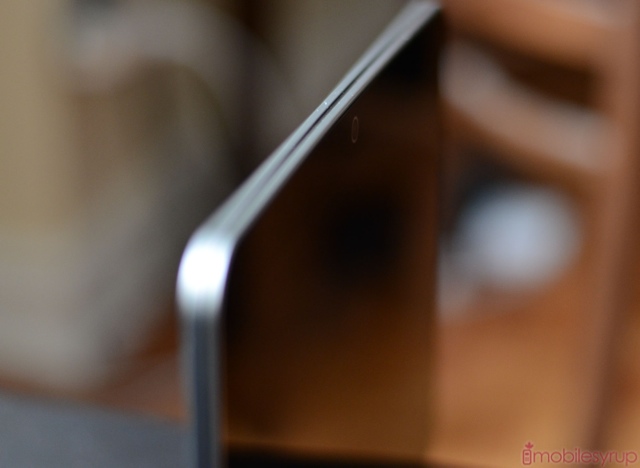
But specs are not important if the tablet runs smoothly, right? The Excite runs a bare-bones version of Android 3.2.1, meaning Toshiba has made no changes to the core operating system. But this is still Honeycomb, and with it comes all the performance problems that were fixed in Android 4.0 Ice Cream Sandwich. General performance is good — browsing the web, playing games, watching video — but it’s tinged with a creakiness, an unavoidable feeling of dead weight that Google managed to lift in ICS. Whether scrolling through the various homescreens or waiting an extra second or two for an app to open, it’s obvious that Honeycomb, like its smartphone equivalent Gingerbread, needs to disappear, and soon.
As I stated earlier, the Excite has trouble with touch precision. On its best day Honeycomb is not altogether 1:1 responsive: there are often times that it just doesn’t respond to input, or takes a second too long to acknowledge. The problem is exacerbated by Toshiba’s lacklustre screen, which will altogether ignore you given half the chance. This made typing a chore, and forced me to use the included version of Swype, on which I managed to struggle through a few paragraphs of this review as a test.
When touch does work, the experience is pleasant enough: watching Netflix was great, as was reading a book on Google Play. Apps that are designed for the big screen look and feel great on the Excite, but every once in a while one will act up, force close and remind us that we’re using Honeycomb.
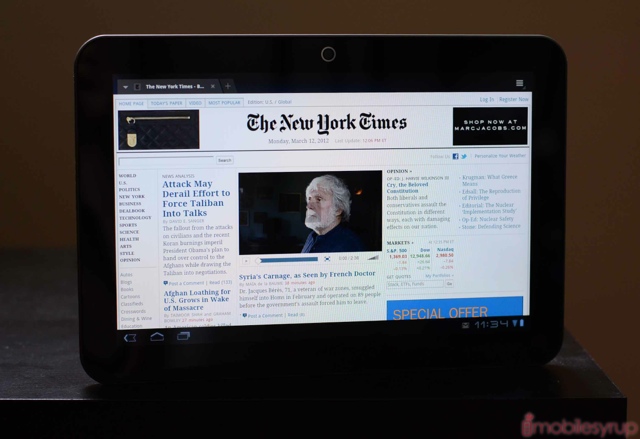
Software:
Toshiba includes a bunch of interesting paid apps on the Excite, some more useful than others. They’ve bundled ThinkFree’s Office Suite: Calc (spreadsheets), Show (presentations), and Write (documents). All of them are functional, responsive and adapted fairly well to the Android platform, with drop-down menus mimicking the majority of basic desktop tasks. For example, in ThinkFree Write it is possible to create number lists, insert tables, photos, clip art, and even draw your own patterns using the built-in Scribble Pad. With support for exporting to Microsoft Office’s .docx (and Excel/Powerpoint equivalents), ThinkFree’s Office Suite is a great addition, especially since it costs $10 in the Google Play Store.
The rest of the bundled apps are not quite as exciting: Toshiba decided not to pay the $7.12 for Splashtop Remote Desktop HD, instead bundling the free version of the popular remote desktop program. If you’ve used VNC, LogMeIn or Citrix GoToMeeting you’ll be familiar with how Splashtop works: you install a client on your Windows or OS X machine and log in using a username and password. Splashtop differentiates by claiming to be able to stream high-resolution video and audio from your computer to the tablet, though I’d imagine it would depend upon the speed of your connection. You can even play 3D games, watch Flash videos and transfer files between devices. We couldn’t find the Free version on the Play Store to know what you don’t get, but the bundled version seems pretty feature-filled.
The remaining fare equates to McAfee’s Mobile Security app which, once configured, protects your device from malware and thieves by tracking its location; and Toshiba’s DLNA-enabled Media Player, which finds media servers connected to the same WiFi network and shares music, photos, video and files to connected devices. Both apps work well, and thankfully the former can be deleted. Also bundled are PrinterShare and TuneWiki, both perfectly able and yet ill-adapted to tablets.
Camera:
The 5MP camera on the Toshiba Excite is perfectly adequate for taking the odd still photo. In good lighting, the sensor is not good at accurately adjusting white balance, so the majority of our photos were washed out. That being said, colours look good and there is no more grain than the average tablet camera. Focusing is fast and the shutter is reasonably quick, making the experience better than the majority of other Android tablets.
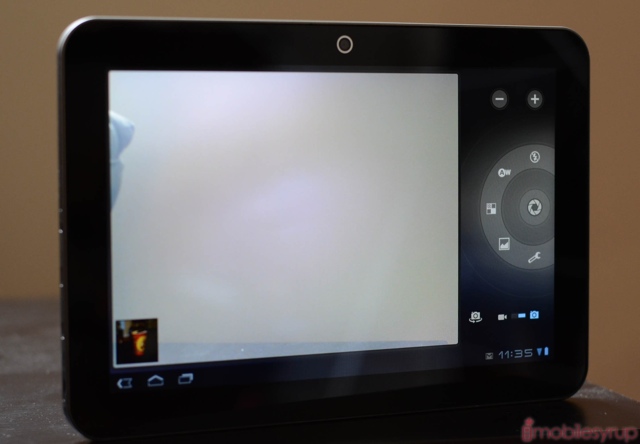
The same thing can be said for the tablet’s video, which is capable of achieving 1080p recording at 30fps. While detailed, the results lack image stabilization, and audio captured from the microphone is quite poor. On the front of the device, the 2MP camera is more than capable of capturing you at your best, or worst, in grainy, washed-out perfection. Thankfully Toshiba saw fit to amp up the resolution of the front-facing camera, though the tiny sensor captures what appears to be the same amount of detail as the iPad’s VGA equivalent.
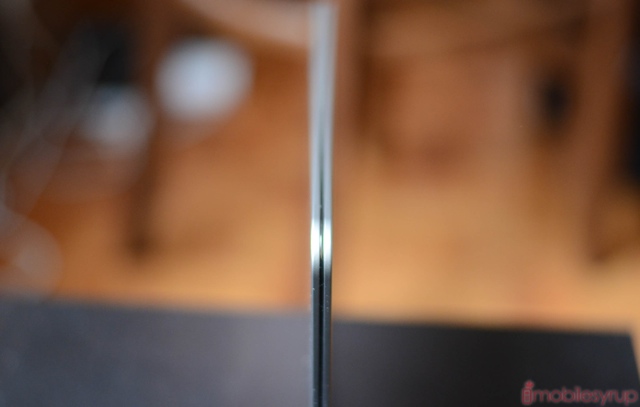
Battery Life:
The 25Whr cell inside the Excite 10 LE is non-removable, unlike the previous-generation Thrive, and offers up to eight hours of continuous usage. With no 3G baseband and a reasonably efficient processor I had no trouble reaching, and surpassing, that number. The auto brightness setting is fairly conservative, and I found myself having to manually set luminance to around 50% for optimal viewing. Left to its own devices the Excite tends to push brightness below 30%, leaving the screen difficult to read in most lighting conditions. It’s nice to see that, despite the Excite’s lithe profile it still managed to compete with the majority of Android tablets on the market.
On our video looping tests, in which I played a 720p-encoded video until the battery died, the Excite achieved 7 hours and 28 minutes which is a reasonable amount of time for a tablet and should get you across the Atlantic without having to recharge.
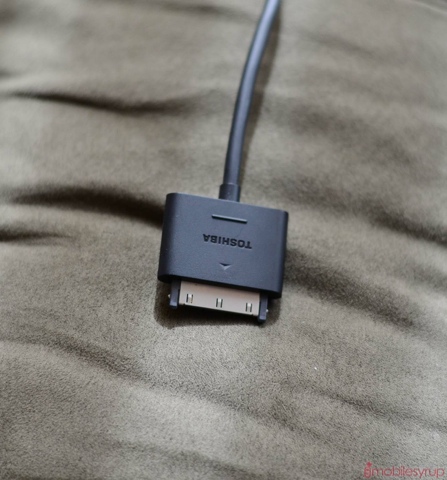
Sound and Connectivity:
The Excite boasts “exclusive sound enhancements by Toshiba and SRS Labs,” and indeed there are options in the Settings to boost volume, optimize voice clarity and equalize ambient noise. All of these settings, except for volume boost, are enabled by default and though I found no discernable difference in quality between the “On” and “Off” settings. The SRS option certainly opens up the sound stage by artificially separating the left and right channels. It also has a side effect of boosting the volume by increasing dynamic range — essentially emphasizing lows and highs while maintaining the midrange. I won’t say the effect is unpleasant, and in a noisy environment the SRS effects are advantageous, but only certain music benefits from such “enhancements.”
Though the Excite does not have full-sized SD, USB and HDMI ports, their mini variety are a nice addition to the slim tablet. Being able to selectively mirror HD content to your TV is a nice bonus, though the box does not come with the necessary mini-to-full HDMI cable. And, like all Android tablets with USB input, the Excite can function as a host, allowing you to access files on your from portable hard drives, or to recognize and use a mouse and keyboard. Many of these devices, however, require full-sized USB inputs, somewhat limiting the tablet’s potential as a full-blown laptop replacement. Nevertheless the abilities are there, and with a little creativity the Excite has a lot of potential as a part-time laptop.
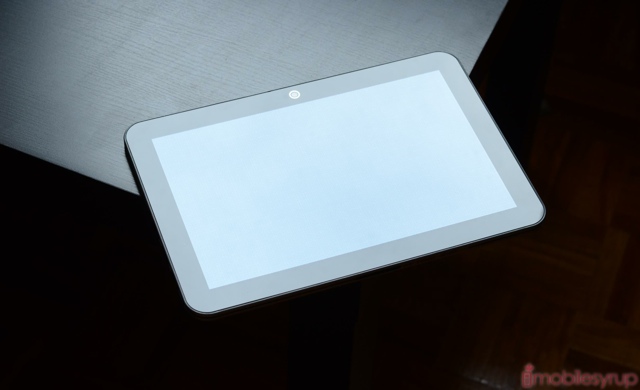
Conclusion:
The Toshiba Excite 10 LE is unlikely to win over the hearts of Android users, especially for the price. At $549.99 for 16GB and $599.99 for the 32GB model, the tablet is wildly overpriced. Though there are some very notable design improvements over its previous generation, and is quite beautiful to look at, the Excite lacks the very quality that one requires in a compelling Android tablet: differentiation. It runs last year’s software on last year’s hardware at this year’s price. Being able to boast of being the thinnest tablet is not reason enough to spend $150 more than the Samsung Galaxy Tab 10.1, which competes with the Excite on every level despite being nearly a year old.
While Toshiba is promising an upgrade to Ice Cream Sandwich, they have yet to release a timeline. Even if it had been released with Android 4.0 it would be difficult to recommend the Excite over the Asus Transformer Prime, but as it stands it doesn’t even enter the picture.
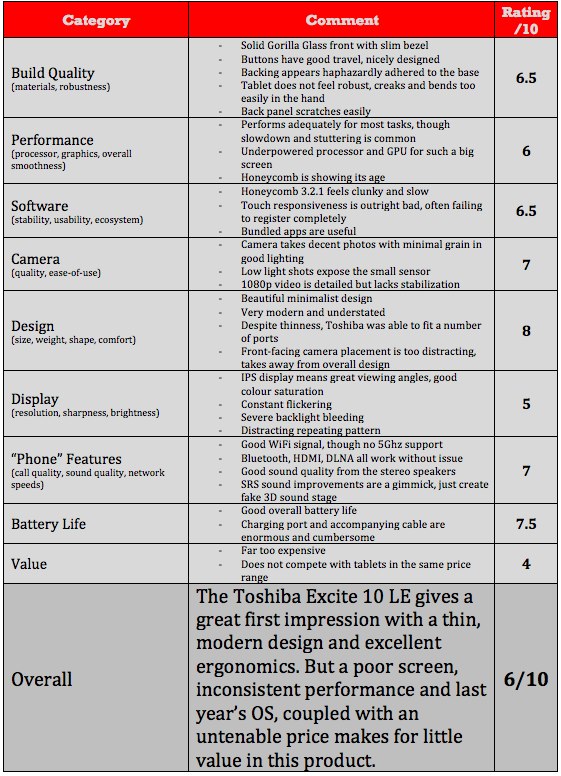
MobileSyrup may earn a commission from purchases made via our links, which helps fund the journalism we provide free on our website. These links do not influence our editorial content. Support us here.

